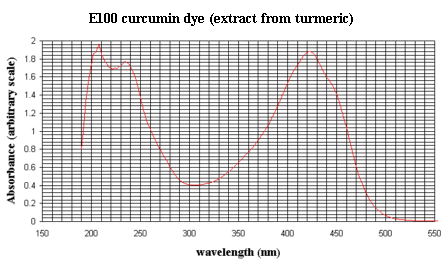 EEC code E100,
EEC code E100, Turmeric, Curcuma longa, is not indigenous to Jamaica, and although production figures have been declining over the last few years, it is still grown here and exported to the USA. It has been estimated that the total world production of turmeric exceeds 160,000 tons.
It is a robust, perennial, tropical herb of the ginger family and like ginger has a
thick, round rhizome with short blunt "fingers".
In some ways, it has been compared to saffron, since not only does it act as a spice, but
it affords a fluorescent yellow-coloured extract of a mixture of three dyestuffs,
including curcumin
which has been known for many centuries to give a rich colour to silks and cottons. The indicator properties of turmeric were noted by H.A. Vogel in 1815
CurcuminCurcumin from turmeric is a yellow dye |
Curcumin is insoluble in water, although metal complexes with tin or zinc are soluble.
For spectral files of other dyes in confectionery see the site at Lappeenranta
University of Technology.
The most outstanding use of turmeric is as an important component of curries, to which it not only imparts a vivid yellow colour but adds a distinctive pungent flavour.
Since turmeric is extremely sensitive to light, curry powders for this reason must be stored in the dark.
A novel use caught my eye.
A source at the Colombo Observatory, quoted in the Sri Lanka Daily News, advised people
who intended to watch the partial solar eclipse on Tuesday 24th Oct 1995, that they should
add a bit of cow dung or turmeric powder to water basins prior to watching the sun's
reflection, since this would protect their eyes.
Created 22nd Sept 1995. Last modified 21st April-98.
URL http://wwwchem.uwimona.edu.jm:1104/lectures/turmeric.html